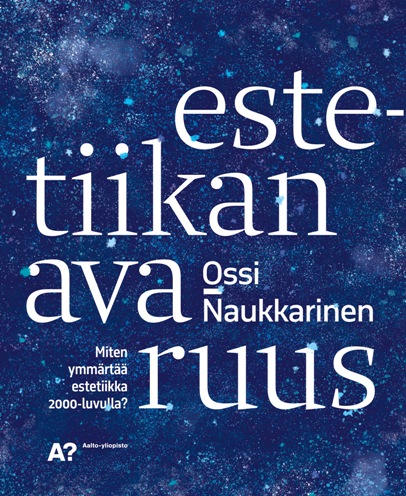The Cosmography of Aesthetics
Yrjö Sepänmaa
Summary of The Universe of Aesthetics: How to Understand Aesthetics in the 21st Century by Ossi Naukkarinen
Ossi Naukkarinen, Estetiikan avaruus: Miten ymmärtää estetiikka 2000-luvulla? (Helsinki: Aalto ARTS Books, Aalto University, 2018), 223 pp., in Finnish. ISBN 978-952-60-7971-4
Ossi Naukkarinen, the first Professor of Aesthetics at Aalto University and currently the Vice President at the university, has been exploring the significance of teaching and research in the humanities and its relationship to humanism as a worldview and way of life. His newest publication addresses this issue in light of his long-standing interest and work in aesthetics.
To Naukkarinen, aesthetics at its broadest is an umbrella concept within which there a re innumerable lower-level systems, some highly developed, some vague; these larger and smaller pieces form dynamic constellations and networks. Within this space, the observer always has a space-time position, being “at home in the universe.” First comes one’s own body, from it, in widening rings, clothes and dressing, home, work and leisure, environment, country, the world.
Naukkarinen introduces a new concept and term, an estheme. Esthemes are material or immaterial units, elements, which are located in physical or conceptual space. Esthemes vanish and new ones arise, their shape changes and some of them combine. The basic type of an estheme is a work of art, but esthemes are also theories of art and their components, as well as natural and cultural objects. The model recalls the transfiguration of art, a miraculous conversion supported by theory.
But is art the most important of esthemes, really? In the opinion of Naukkarinen and many others, it is. Returning to his space metaphor and invoking the heliocentric model, but without assigning the most important place to art, he writes: “… however, art has the position of at least a large planet in the space of aesthetics, if not of the sun that is the centre-point of all… .” On the outskirts lies an aestheticizing and artifying satellite zone.
In aesthetics, many different languages are spoken. Naukkarinen quotes a musicological analysis, which is foreign to him. Likewise, I can refer to the film Arrival (2016), in which space beings, aliens, communicate by spraying sorts of ink clouds that solidify in lace-like patterns. A brilliant linguist identifies this as an attempt at communications, succeeds in decrypting the code, and establishes a discussion link. Such is also Naukkarinen’s future vision of an “art museum of artificial intelligences,” the doors of which are closed to humans – for the time being.
The book’s sub-title binds the treatment to the expanded present-time. Naukkarinen ends with similar ideas of the overlapping of past, present, and future as Arthur C. Danto in his article (Artforum 28:9, 1990) dealing with the prediction (haruspicy) of the present and future of contemporary art. Not everything made and happening at the present time is contemporary; on the other hand, the lost and forgotten is continually activated from history as part of the present, and the classics are fixed stars. The future of aesthetics is bound, above all, not only to the emergent birth of phenomena classified as aesthetic, but also to the execution of manifestos and visions.
One way of demanding the control of developed data technology to envisage the contemporary field of aesthetics is to look at digital databases’ big data, the researchers’ references, key words, tables of contents of journals, anthologies, and books in the field, and the prospects of educational institutions. Together with his colleagues, Naukkarinen has developed methods of sifting large masses of data.
For whom, then, has Naukkarinen written this book? “Everybody,” he replies. A few times he speaks to presumed student readers, encouraging them to engage in independent thought but not giving systematic information on schools and methods. Important names in the field appear in short references, as if speaking of common acquaintances. Despite the book’s lightness and informal first impression, Naukkarinen’s essay is more of a broad-minded monologue by one who has been long active in the field, the ideal reader being a senior colleague who understands the references and notes the transparent trains of thought, or a long-term professional in aesthetic culture who is well-trained in practical tasks.
The pattern recalls a star architect’s wild sketch, which is then given to the office’s assistants to develop and implement. Even the graphic design of the book and its cover encourages one to think big. The cover’s starry sky on a dark blue background features constellations that are drawn depicting modern life, though without names, one of which is a portrait of the author. The researcher seeks on the one hand a total picture of the universe and on the other concentrates on human nature and himself. Thus, Naukkarinen’s lively enquiring mind moves between the public and private spheres.

Yrjö Sepänmaa
yrjo.sepanmaa@uef.fi
Professor of Environmental Aesthetics (Emeritus), University of Eastern Finland, Joensuu.
Published January 3, 2019.
Cite this article: Yrjö Sepänmaa, “The Cosmography of Aesthetics,” Contemporary Aesthetics 17 (2019), accessed date.
